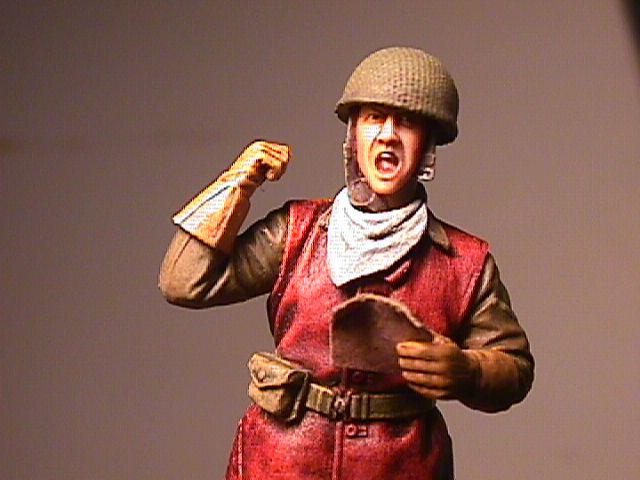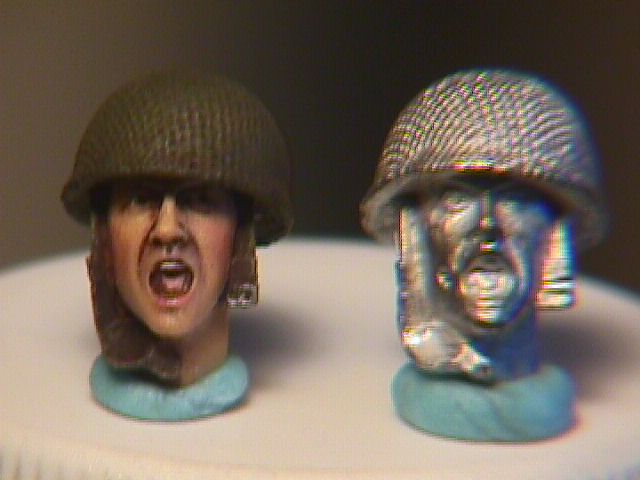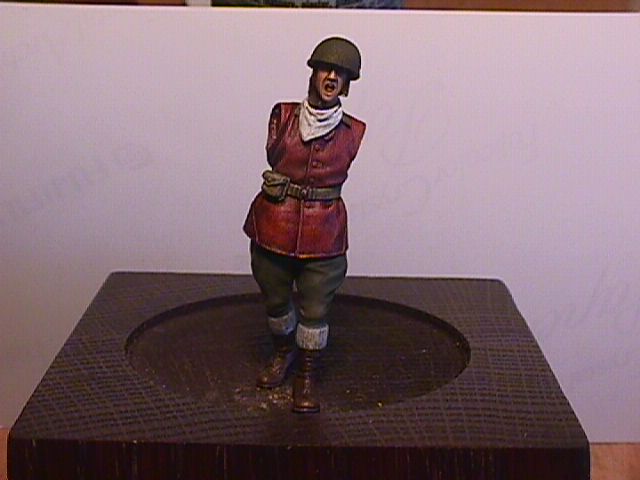

Painting a British Dispatcher Figure
Mark Bannerman

I chose this subject because I recently purchased a Scale Model
Accessories' Triumph motorcycle. And I 've been meaning to do this subject for a long
time. My Grandfather was a dispatcher rider throughout WWII. Interestingly, he never rode
a Triumph. Instead, he spent the latter part of the war zipping around on a stolen
BMW/side car :)
This figure is one of Hornet's fine 1/35th scale offerings of a British Dispatcher. He
comes in white metal, separate arms and head and a revolver holster. Clean up was minimal
though there are some seams you will need to clean up between the legs.
References tend to be slim but did find some decent photos thanks to Mark Stares' colour
book on British uniforms. The only alteration I made was swapping the head for one of
Hornet's head for the Running Paratroop" figure. He just needed to look like he was
shouting an order of sorts.
After minor clean up of seam lines, and leaving the head and arms unattached, I cleaned up
the figure with vinegar and an old toothbrush and left it to thoroughly dry. This gave the
metal some tooth to take the primer. I primed the figure with Tamiya metal Primer. A
few light coats will do just fine. The figure was then sprayed entirely with Tamiya Gloss
White cut with rubbing alcohol. Once dry, I checked to see if all the seam lines and seams
were removed. Any air bubbles were filled with car filler. I again resprayed the figure
lightly with Tamiya Acrylic Gloss White.
Once the base was perfectly dry - 24 hours - I proceeded to examine how best to
approach the figure. My thoughts were to paint the leather immediately as it is a
prominent part of the figure and then paint the details afterwards. The first step was
laying a very thin cote of Burnt Sienna mixed with Mars Red oils on the entire jacket.
Before applying the paint, I generally place the oil on paper for one hour so that some of
the oils in the paint are soaked up. The more oil in the paint, the longer the
drying period. You do want to leave some oils in the paint as this will provide the sheen
of natural leather.
When you begin the process of applying Burnt Sienna/Mars Red over the entire jacket, pay particular attention to placing the paint in all shadow areas and inside all seams. I stress very thin coats as this will be important when you apply the second coat. Think of it as staining the white on the jacket as opposed to actually stroking and painting it. You want to make sure that you can still see the white through the oil mix. Let this to sit under a glass to dry for about an hour.
While the oil paint is still wet, I take a wide but soft dry brush and lightly whisk it downwards from the shoulder to the edge of the jacket going around the figure. Only one pass will be necessary. Do not stroke or scrub downwards in the same area more than once. Just go around and whisk the jacket. What you are doing is drawing excess oil paint paint off the highlight points and literally disposing it in the shadow areas. When you have completed this task, sit back and look at the jacket. The shadow areas are taking a darker tone while highlight points look extremely light, almost white.

Because the drying time is long (48 hours) for oils, I would like to
suggest you leave the oils to dry for at least a week as this will become very
important in the further painting process of leather. During this week long period, I
decided to paint the trousers. The trousers were painted in acrylics combining
Tamiya Khaki mixed with Tamiya Dark Yellow. I was not certain if this was the right tone
but close enough in my mind. This was applied very thinly and I then proceeded to apply
Humbrol #155 Olive Drab mixed with Gold Ochre oil paint for the shadows. While Humbrols do
dry rather quickly, mixing oils in the enamels allows for more "wet" time and
also allows to work the wet highlights into the shadows. I do not generally like to paint
wet on
wet as it is time consuming but this technique does allow for gradual shadows and
highlights as opposed to sharp borders between highlights and shadows. It is a bit fiddly
to say the least but because the area is quite small and controllable, it took all of 25
minutes to apply the base paint, highlight, shadow and blend the trousers. For the
highlight areas, I added more Gold Ochre to the Humbrol #155 and last highlight touches
included pure Titanium White to the highlight mix. To finish off the trousers, I applied
some Humbrol #29 and #72 to the knee areas to show just a little wear and tear.
I painted the boots in Humbrol Natural Wood, and when dry applied a wash of Sepia (or black) oils. The "woollies" were a little difficult because there was very little in the way of coiling. So I applied my X-acto knife and made as many horizontal fine lines I possibly could within such a small space. The sox were then painted a mix of white and grey, both Humbrol, a small wash of dark grey Humbrol followed and lightly dry-brushed with pure white (oils).
I came back to the figure a few weeks later and proceeded with step two on
the leather jacket. This time, I used the same technique as above for the Burnt Sienna
but I then used Raw Umber oils with Mars Red oils mixed in. The process is similar
to the painting of the Italian Tanker in this article section with the exception of going
for a more reddish tone which is typical of English leathers. Using above technique,
ensure it is a thin coat and apply right over the dry Burnt Sienna/ Mars Red, always
making sure to get inside the seams. Let it sit for an hour and similarly lightly whisk
with a soft dry brush downwards over highlight leaving the paint your are drawing
into the shadow areas. Now you have a jacket that has very light highlights and very dark
shadows. Let this sit for two days under a glass and come back to it. If you feel it
is still to light and are looking for a
darker shade, wait another week and apply a mix of Black oils with Burnt Umber/Mars Red
(50-50) using same technique.
The face was primed in Tamiya Metal Primer and painted similarly to the article on
painting faces - with the exception of minimizing the 5 o'clock shadow to just above his
upper lip - going for the clean cut type.
The last step was painting the webbing, gauntlet, "napkin"and
arms. The belt was painted Tamiya Khaki, washed with Humbrol #155 and drybrushed with
Humbrol #150 mixed with Gold Ochre oils. The gauntlets were painted in white oils mixed
with Humbrol #93. When dry, highlighted with Yellow Ochre/Burnt Sienna oils and shadows
were in Payne's Grey. The "napkin"
around his neck was used to protect his face from flying rocks and dust. This could be any
colour - I chose plain ol' white. This was painted using Humbrol white, shadowed with Raw
umber mixed with Payne's Grey and highlighted with Humbrol White. For the arms and partial
collar, I painted these with a mix of Tamiya Khaki with Tamiya Desert Yellow , highlighted
in Humbrol Dark Yellow #93 and shadowed with Humbrol #150. I' m not entirely satisfied
with this and will probably redo these. At
time of photo, the chevron was not painted.
The document in his left hand is a piece of newspaper, soaked in my morning coffee, dabbled through some white glue and placed in his hand. Hope it stays that way :) That wraps up a fun project...compared to the motorbike which is a 100-piece all metal job with seams everywhere ! Definitely not an evening job by any stretch of the imagination. Though Tamiya' s BMW/sidecar is looking very interesting by the minute ....and much closer to home, as it were :)

| Main | What's New | Articles | Reviews | Gallery | Think Tank | Contests |